Cessna 206
| Cessna 205, 206 & 207 | |
|---|---|
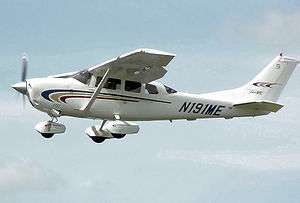 | |
| 2000 model Cessna 206H Stationair | |
| Role | Light aircraft |
| Manufacturer | Cessna |
| Introduction | 1962 (206) |
| Status | In production |
| Primary users | Yute Air Alaska Argentine Army |
| Produced | 1962-1986 and 1998-present |
| Number built | over 8509 (as of approx. 2006) |
| Unit cost | |
| Developed from | Cessna 210 |
The Cessna 205, 206, and 207, known variously as the Super Skywagon, Skywagon, Stationair, and Super Skylane are a family of single-engined, general aviation aircraft with fixed landing gear, used in commercial air service and also for personal use. The family was originally developed from the popular retractable-gear Cessna 210 and is produced by Cessna.
The line's combination of a powerful engine, rugged construction and a large cabin has made these aircraft popular bush planes. Cessna describes the 206 as "the sport-utility vehicle of the air." These airplanes are also used for aerial photography, skydiving and other utility purposes. They can also be equipped with floats, amphibious floats and skis. Alternatively, they can be fitted with luxury appointments for use as a personal air transport.
From 1962 to 2006 Cessna produced 8,509 aircraft in the 205, 206 and 207 variants.
Development
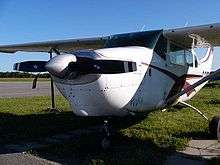

.jpg)
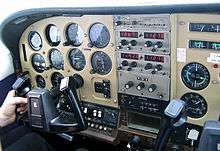
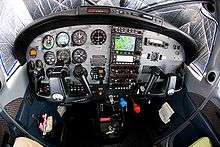




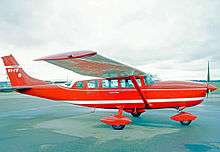
Cessna 205
_092.jpg)
The Cessna 205 was introduced late in 1962 as a 1963 model year. The six-seat aircraft was essentially a Cessna 210 with fixed landing gear and with changes to the crew and passenger door arrangement, being officially designated by Cessna as a "Model 210-5".[3] The 205 retained the early 210’s engine cowling bulge, originally where the 210 stowed its nosewheel on retraction. This distinctive cowling was made more streamlined on the later Cessna 206.
The 205 is powered by a Continental IO-470-S engine producing 260 hp (190 kW).[4]
The 205 was produced in only two model years - 1963 and 1964 before being replaced in production by the Cessna 206. A total of 576 Cessna 205s were produced.[4]
Cessna 206
The six-seat Model 206 was introduced as a 1964 model and was built until 1986, when Cessna halted production of its single-engined product line. It was then re-introduced in 1998 and remains in production in 2013.[4]
There were many sub-variants, including the U206, P206 all certified to CAR3 standards and later 206H certified to FAR Part 23.
The total Model 206 production between 1964 and 2004 was 6,581 aircraft.[4]
Cessna U206
The original 1964 model was the U206, powered by a 285 hp (213 kW) Continental IO-520-A. The “U” designation indicated “utility” and this model was equipped with a pilot side door and large clamshell rear door serving the back two rows of seats, allowing easy loading of oversized cargo.[4]
There was a TU206 turbocharged version powered by the Continental TSIO-520-C engine producing 285 hp (213 kW). After 1967 the turbo TU206 was powered by a TSIO-520-F of 300 hp (220 kW). The extra 15 hp (11 kW) was obtained by turning the engine at a higher rpm, and was allowed for only five minutes.[4] Due to the large propeller diameter, the additional engine speed meant that the propeller tips were pushed to transonic speeds, which required much more power.
From 1964 to 1969 the U206 was known as the “Super Skywagon”. From 1970 it was named the “Stationair”, a contraction of “Station Wagon of the Air”, which is a good description of the aircraft's intended role. Sub-variants were designated U206 to U206G.[4]
In 1977 the U206 had its engine upgraded to a Continental IO-520-F of 300 hp (220 kW) (continuous rating, obtained at a lower speed than the previous IO-520-F) and the TU206 powerplant was changed to the TSIO-520-M producing 310 hp (230 kW).[4]
Production of all versions of the U206 was halted in 1986 when Cessna stopped manufacturing all piston-engined aircraft. A total of 5,208 U206s had been produced.[4]
Cessna P206
The P206 was added to the line in 1965. In this case the “P” stood for “people”, as the P206 had passenger doors similar to the Cessna 210 from which it was derived, on both sides.[4]
The P206 was produced from 1965 to 1970 and was powered by a Continental IO-520-A of 285 hp (213 kW). There was a turbocharged model designated TP206 which was powered by a Continental TSIO-520-A also of 285 hp (213 kW).[4]
647 P206s were produced under the name “Super Skylane” which made it sound like a version of the Cessna 182, which it was not. Sub-variants were designated P206 to P206E.[4]
Cessna 206H
After a production hiatus of twelve years, Cessna started manufacturing a new version of the venerable 206 in 1998, with the introduction of the newly certified 206H.[4] The “H” model is generally similar to the previous U206 configuration, with a pilot entry door and a rear double clamshell door for access to the middle and back seats. The "H" is marketed under the name "Stationair".
The 206H is powered by a Lycoming IO-540-AC1A powerplant producing 300 hp (220 kW). The turbocharged T206H is powered by a Lycoming TSIO-540-AJ1A engine of 310 hp (230 kW).[4]
Even though the Cessna 206H is certified as a six-seat aircraft in its country of origin, the Canadian aviation regulator, Transport Canada has certified it to carry only five people in Canada. This is due to concerns about passenger egress through the rear clamshell door with the flaps extended. Cessna addressed one part of this problem early on, after a flight-test aircraft was damaged when the pilot extended the flaps while taxiing, and his passenger had the clamshell door open (for ventilation; it was a hot summer day). A switch was added to the flap actuation circuit which disabled the flaps when the doors were open. The other part of the problem is that if the flaps are already down, the passenger must perform the complicated procedure of opening the front part as far as possible (about 2 in (5.1 cm)) then open the rear door and restow the rear door handle. This then gives enough clearance to open the rear part of the door.
Both the 206H and the T206H remain in production in 2013. By the end of 2004 Cessna had produced 221 206Hs and 505 T206Hs, for a total production of 726 "H" models.[4]
Cessna has indicated that they do not intend to produce a P206-configuration aircraft in the future, due to lack of market demand.
Cessna 207
The Model 207 was a seven- and later eight-seat development of the 206, achieved by stretching the design further by 45 inches (114 cm)[5] to allow space for more seats. The nose section was extended 18 inches (46 cm) by adding a constant-section nose baggage compartment between the passenger compartment and the engine firewall; the aft section was extended by 27 inches (69 cm)[6] by inserting a constant-area section in the fuselage area just aft of the aft wing attach point. Thus the propeller's ground clearance was unaffected by the change (the nosewheel had moved forward the same distance as the propeller), but the tail moved aft relative to the mainwheel position, which made landing (without striking the tailskid on the runway) a greater challenge. The move gave that airplane a larger turning radius, since the distance between mainwheels and nosewheel increased by 18 inches (46 cm) but the nosewheel's maximum allowed deflection was not increased.
The 207 was introduced as a 1969 model featuring a Continental IO-520-F engine of 300 hp (220 kW). A turbocharged version was equipped with a TSIO-520-G of the same output.[4]
At the beginning of production the model was called a Cessna 207 “Skywagon”, but in 1977 the name was changed to “Stationair 7”. 1977 also saw a change of engine on the turbocharged version to a Continental TSIO-520-M producing 310 hp (230 kW) – the same engine used in the TU206 of the same vintage.[4]
The 207 added a seat in 1980 and was then known as the “Stationair 8”. Production of the 207 was completed in 1984, just two years before U206 production halted. A total of 626 Cessna 207s were manufactured.[4]
The Cessna Model 207 has been popular with air taxi companies, particularly on short runs where its full seating capacity could be used. Very few of these aircraft have seen private use.
Modifications
In April 2007 Thielert announced that the European Aviation Safety Agency had granted a Supplemental Type Certificate (STC) for conversion of Cessna 206s to the Thielert V-8 diesel powerplant. The STC allows conversion of the following models: U206F and TU206F with the 300 hp (220 kW) powerplant, and the U206G, TU206G, 206H and T206H with the 310 hp (230 kW) version.[7] This modification does not require any changes to the engine cowling. In May 2008, Thielert entered insolvency proceedings, so the future availability of this diesel conversion is uncertain.[8]
Soloy Aviation Solutions offers a turboprop conversion for some 206/207 models based on the 418 shp (312 kW) Allison C20S engine/gearbox package. However, extensive engine cowl modifications are required.[9]
Atlantic Aero offers an FAA STC conversion to the Continental IO-550 powerplant. No cowl modifications are required.[10]
Both Kenmore Air (Edo floats) and Wipaire (Wipline floats) offer seaplane conversions.[11][12]
Variants
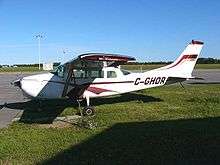
- 205 (Model 210-5)
- Original 205 model, six seats, powered by a Continental IO-470-S of 260 hp (194 kW), with a gross weight of 3,300 lb (1,497 kg) landplane and certified on 14 June 1962 as a variant of the Cessna 210.[3]
- 205A (Model 210-5A)
- Six seats, powered by a Continental IO-470-S of 260 hp (194 kW), with a gross weight of 3,300 lb (1,497 kg) landplane and certified on 19 July 1963 as a variant of the Cessna 210.[3]
- 206
- Original 206 model, six seats, powered by a Continental IO-520-A of 285 hp (213 kW), with a gross weight of 3,300 lb (1,497 kg) landplane, 3,500 lb (1,588 kg) seaplane and certified on 19 July 1963.[13]
- U206 Super Skywagon
- First U206 model, six seats, powered by a Continental IO-520-A of 285 hp (213 kW), with a gross weight of 3,300 lb (1,497 kg) landplane, 3,500 lb (1,588 kg) seaplane and certified on 8 October 1964.[13]
- P206
- First P206 model, six seats, powered by a Continental IO-520-A of 285 hp (213 kW), with a gross weight of 3,300 lb (1,497 kg) landplane, 3,500 lb (1,588 kg) seaplane and certified on 8 October 1964.[13]

- U206A
- Six seats, powered by a Continental IO-520-A of 285 hp (213 kW), with a gross weight of 3,600 lb (1,633 kg) landplane, 3,500 lb (1,588 kg) seaplane, 3,300 lb (1,497 kg) skiplane and certified on 24 September 1965.[13]
- P206A
- Six seats, powered by a Continental IO-520-A of 285 hp (213 kW), with a gross weight of 3,600 lb (1,633 kg) landplane, 3,500 lb (1,588 kg) seaplane, 3,300 lb (1,497 kg) skiplane and certified on 24 September 1965.[13]
- P206B
- Six seats, powered by a Continental IO-520-A of 285 hp (213 kW), with a gross weight of 3,600 lb (1,633 kg) landplane, 3,300 lb (1,497 kg) skiplane and certified on 3 August 1966.[13]
- TU206A
- Six seats, powered by a turbocharged Continental TSIO-520-C of 285 hp (213 kW), with a gross weight of 3,600 lb (1,633 kg) landplane, 3,600 lb (1,633 kg) seaplane, 3,300 lb (1,497 kg) skiplane and certified on 20 December 1965.[13]
- TU206B
- Six seats, powered by a turbocharged Continental TSIO-520-C of 285 hp (213 kW), with a gross weight of 3,600 lb (1,633 kg) landplane, 3,600 lb (1,633 kg) seaplane, 3,300 lb (1,497 kg) skiplane and certified on 3 August 1966.[13]
- TP206A
- Six seats, powered by a turbocharged Continental TSIO-520-C of 285 hp (213 kW), with a gross weight of 3,600 lb (1,633 kg) landplane, 3,600 lb (1,633 kg) seaplane, 3,300 lb (1,497 kg) skiplane and certified on 20 December 1965.[13]
- TP206B
- Six seats, powered by a turbocharged Continental TSIO-520-C of 285 hp (213 kW), with a gross weight of 3,600 lb (1,633 kg) landplane, 3,300 lb (1,497 kg) skiplane and certified on 3 August 1966.[13]
- U206B
- Six seats, powered by a Continental IO-520-F of 300 hp (224 kW), with a gross weight of 3,600 lb (1,633 kg) landplane, 3,500 lb (1,588 kg) seaplane, 3,300 lb (1,497 kg) skiplane and certified on 3 August 1966.[13]
- P206C
- Six seats, powered by a Continental IO-520-A of 285 hp (213 kW), with a gross weight of 3,600 lb (1,633 kg) landplane, 3,300 lb (1,497 kg) skiplane and certified on 20 July 1967.[13]
- TP206C
- Six seats, powered by a turbocharged Continental TSIO-520-C of 285 hp (213 kW), with a gross weight of 3,600 lb (1,633 kg) landplane, 3,300 lb (1,497 kg) skiplane and certified on 20 July 1967.[13]
- P206D
- Six seats, powered by a Continental IO-520-A of 285 hp (213 kW), with a gross weight of 3,600 lb (1,633 kg) landplane, 3,300 lb (1,497 kg) skiplane and certified on 18 September 1968.[13]
- TP206D
- Six seats, powered by a turbocharged Continental TSIO-520-C of 285 hp (213 kW), with a gross weight of 3,600 lb (1,633 kg) landplane, 3,300 lb (1,497 kg) skiplane and certified on 18 September 1968.[13]
- P206E
- Six seats, powered by a Continental IO-520-A of 285 hp (213 kW), with a gross weight of 3,600 lb (1,633 kg) landplane, 3,300 lb (1,497 kg) skiplane and certified on 28 July 1969.[13]
- TP206E
- Six seats, powered by a turbocharged Continental TSIO-520-C of 285 hp (213 kW), with a gross weight of 3,600 lb (1,633 kg) landplane, 3,300 lb (1,497 kg) skiplane and certified on 28 July 1969.[13]
- U206C
- Six seats, powered by a Continental IO-520-F of 300 hp (224 kW), with a gross weight of 3,600 lb (1,633 kg) landplane, 3,500 lb (1,588 kg) seaplane, 3,300 lb (1,497 kg) skiplane and certified on 20 July 1967.[13]
- TU206C
- Six seats, powered by a turbocharged Continental TSIO-520-C of 285 hp (213 kW), with a gross weight of 3,600 lb (1,633 kg) landplane, 3,600 lb (1,633 kg) seaplane, 3,300 lb (1,497 kg) skiplane and certified on 20 July 1967.[13]
- U206D
- Six seats, powered by a Continental IO-520-F of 300 hp (224 kW), with a gross weight of 3,600 lb (1,633 kg) landplane, 3,500 lb (1,588 kg) seaplane, 3,300 lb (1,497 kg) skiplane and certified on 18 September 1968.[13]
- TU206D
- Six seats, powered by a turbocharged Continental TSIO-520-C of 285 hp (213 kW), with a gross weight of 3,600 lb (1,633 kg) landplane, 3,600 lb (1,633 kg) seaplane, 3,300 lb (1,497 kg) skiplane and certified on 18 September 1968.[13]
- U206E
- Six seats, powered by a Continental IO-520-F of 300 hp (224 kW), with a gross weight of 3,600 lb (1,633 kg) landplane, 3,500 lb (1,588 kg) seaplane, 3,300 lb (1,497 kg) skiplane and certified on 28 July 1969.[13]
- TU206E
- Six seats, powered by a turbocharged Continental TSIO-520-C of 285 hp (213 kW), with a gross weight of 3,600 lb (1,633 kg) landplane, 3,600 lb (1,633 kg) seaplane, 3,300 lb (1,497 kg) skiplane and certified on 28 July 1969.[13]
- U206F
- Six seats, powered by a Continental IO-520-F of 300 hp (224 kW), with a gross weight of 3,600 lb (1,633 kg) landplane, 3,500 lb (1,588 kg) seaplane, 3,300 lb (1,497 kg) skiplane and certified on 26 October 1971.[13]
- TU206F
- Six seats, powered by a turbocharged Continental TSIO-520-C of 285 hp (213 kW), with a gross weight of 3,600 lb (1,633 kg) landplane, 3,600 lb (1,633 kg) seaplane, 3,300 lb (1,497 kg) skiplane and certified on 26 October 1971.[13]
- U206G
- Six seats, powered by a Continental IO-520-F of 300 hp (224 kW), with a gross weight of 3,600 lb (1,633 kg) landplane, 3,500 lb (1,588 kg) seaplane and certified on 21 June 1976.[13]
- TU206G
- Six seats, powered by a turbocharged Continental TSIO-520-M of 310 hp (231 kW), with a gross weight of 3,600 lb (1,633 kg) landplane, 3,600 lb (1,633 kg) seaplane, 3,600 lb (1,633 kg) amphibian and certified on 21 June 1976.[13]
- 206H
- Six seats, powered by a Lycoming IO-540-AC1A5 of 300 hp (224 kW), with a gross weight of 3,600 lb (1,633 kg) landplane and certified on 26 November 1997.[13]

- T206H
- Six seats, powered by a turbocharged Lycoming TIO-540-AJ1A of 310 hp (231 kW), with a gross weight of 3,600 lb (1,633 kg) landplane and certified on 1 October 1998.[13]
- 207 Skywagon
- Original 207 model, seven seats, powered by a Continental IO-520-F of 300 hp (224 kW), with a gross weight of 3,800 lb (1,724 kg) landplane and certified on 31 December 1968.[14]
- T207 Turbo Skywagon
- Seven seats, powered by a turbocharged Continental TSIO-520-G of 300 hp (224 kW), with a gross weight of 3,800 lb (1,724 kg) landplane and certified on 31 December 1968.[14]
- 207A Skywagon/Stationair 8
- Seven seats, powered by a Continental IO-520-F of 300 hp (224 kW), with a gross weight of 3,800 lb (1,724 kg) landplane and certified on 12 July 1976. Certified for eight seats on 11 September 1979.[14]
- T207A Turbo Skywagon/Turbo Stationair 8
- Seven seats, powered by a turbocharged Continental TSIO-520-M of 310 hp (231 kW), with a gross weight of 3,800 lb (1,724 kg) landplane and certified on 12 July 1976. Certified for eight seats on 11 September 1979.[14]
Operators
Civil
The aircraft is popular with air charter companies and small cargo air carriers, and is operated by private individuals and companies. One of the largest Cessna 207 operators is Yute Air Alaska, which has a fleet of 12 aircraft.[15]
Government
- Ottawa Police Service - one U206G in the surveillance aircraft role[16]
- California Highway Patrol - Multiple for speed enforcement
- Nebraska Highway Patrol
- North Dakota Highway Patrol
- North Dakota Fish and Game
- South Dakota Highway Patrol
Military
- Argentine Army, six × T207[17]
- Bolivian Air Force, two × U206C and 7 × TU206G[18]
- Chilean Air Force, Operated between 1974 and 1980 the very first Cessna 206 (c/n 0001) as FACh 415, then sold it to civilian market.[19]
- Djibouti Air Force, one × U206G[20]
- Paraguayan Air Force 5 U206G
- Paraguayan Naval Aviation 4 U206A/C
- Paraguayan Army Aviation 2 U206G
Accidents
- December 4, 1971 – Eastern Airlines Flight 898 (a Douglas DC-9-31) collided with a Cessna 206 (N2110F) while landing at Raleigh-Durham International Airport. The Cessna crashed, killing two people on the plane, but the DC-9 landed safely.[23][24]
- July 24, 1972 near Aspen, Colorado, a 27-year-old student pilot with a total of 39 hours of flying time flew into a blind canyon and stalled the aircraft while trying to turn around, killing all four people on board. Among the passengers was wealthy playboy, entrepreneur, racing driver and developer Lance Reventlow, who was a Woolworth heir, son of Barbara Woolworth Hutton and the husband of former Mouseketeer and actress Cheryl Holdridge.[25]
Specifications (206H Stationair)
Data from Jane's All The World's Aircraft 2003–2004[26]
General characteristics
- Crew: one
- Capacity: five passengers
- Length: 28 ft 3 in (8.61 m)
- Wingspan: 36 ft 0 in (10.97 m)
- Height: 9 ft 3½ in (2.83 m)
- Wing area: 175.5 ft² (16.30 m²)
- Airfoil: NACA 2412 (modified)
- Empty weight: 2,176 lb (987 kg)
- Max. takeoff weight: 3,600 lb (1,632 kg)
- Powerplant: 1 × Lycoming IO-540-AC1A air-cooled flat-six engine, 300 hp (224 kW)
Performance
- Maximum speed: 174 mph (151 knots, 280 km/h) at sea level
- Cruise speed: 163 mph (142 knots, 263 km/h) at 6,200 ft (1,890 m)
- Stall speed: 63 mph (54 knots, 100 km/h)
- Range: 840 mi (730 nmi, 1,352 km)
- Service ceiling: 15,700 ft (4,785 m)
- Rate of climb: 988 ft/min (5.0 m/s)
See also
- Related development
- Aircraft of comparable role, configuration and era
References
- ↑ 2012 206H Stationair Price List
- ↑ 2012 T206H Stationair Price List
- 1 2 3 Federal Aviation Administration (February 2009). "TYPE CERTIFICATE DATA SHEET NO. 3A21 Revision 47" (PDF). Retrieved 20 March 2010.
- 1 2 3 4 5 6 7 8 9 10 11 12 13 14 15 16 17 18 Aircraft Bluebook Spring 2006 Edition Penton Media, Overland Park, KS USA
- ↑ Taylor 1971, p. 280.
- ↑ Simpson 2005, p. 86.
- ↑ du Cros, Andre Teissier (May 2006). "Thielert announces major new products". Retrieved 2007-11-14.
- ↑ Niles, Russ (April 2008). "Thielert Aircraft Engines Files For Insolvency". Retrieved 2008-04-26.
- ↑ Soloy Aviation Solutions (n.d.). "Turbine Cessna 206 Mark 1 Conversion". Retrieved 2007-11-14.
- ↑ Atlantic Aero (n.d.). "550 Stationair" (PDF). Retrieved 2007-11-14.
- ↑ Kenmore Air (n.d.). "Float Models". Retrieved 2010-07-07.
- ↑ Wipaire (2007). "Wipline 3450 Floats". Retrieved 2007-11-14.
- 1 2 3 4 5 6 7 8 9 10 11 12 13 14 15 16 17 18 19 20 21 22 23 24 25 26 27 28 29 Federal Aviation Administration (February 2009). "TYPE CERTIFICATE DATA SHEET NO. A4CE Revision 47" (PDF). Retrieved 20 March 2010.
- 1 2 3 4 Federal Aviation Administration (February 2009). "TYPE CERTIFICATE DATA SHEET NO. A16CE Revision 22" (PDF). Retrieved 20 March 2010.
- ↑ Niles, Russ (August 2010). "30,000 Hours on Gravel". Retrieved 14 August 2010.
- ↑ Transport Canada (3 June 2015). "Canadian Civil Aircraft Register". Retrieved 3 June 2015.
- ↑ Andrade 1982, p. 13
- ↑ Andrade 1982, p. 27
- ↑ "El primero de muchos". ModoCharlie. 2014-03-09. Retrieved 2014-03-23.
- ↑ Andrade 1982, p. 55
- ↑ Ecuador Air Arms - Fuerza Aérea Ecuatoriana Archived July 31, 2010, at the Wayback Machine.
- ↑ Flores 2001, p. 301.
- ↑ National Transportation Safety Board (December 1971). "NTSB Identification: NYC72AN074". Retrieved 2014-06-18.
- ↑ National Transportation Safety Board (December 1971). "NTSB Identification: NYC72AN074". Retrieved 2014-06-18.
- ↑ "DEN73AD003". Ntsb.gov. Retrieved 2013-04-24.
- ↑ Jackson 2003, pp. 590–591.
Bibliography
- Cessna 206H Specifications
- Thielert Aircraft Engines GmbH Press release about Cessna 206 engine development
- Cessna 206 Soloy Specification
- Andrade, John (1982). Militair 1982. London: Aviation Press Limited. ISBN 0-907898-01-7.
- Flores, Santiago A. (May 2001). "From Cavalry to Close Air Support". Air International. Vol. 60 no. 5. pp. 298–303. ISSN 0306-5634.
- Taylor, John W.R. (1971). Jane's All The World's Aircraft 1971–1972. London, UK: Jane's Yearbooks.
- Jackson, Paul (2003). Jane's All The World's Aircraft 2003–2004. Coulsdon, UK: Jane's Information Group. ISBN 0-7106-2537-5.
- Simpson, Rod (2005). The General Aviation Handbook. Hinckley, UK: Midland Publishing. ISBN 1-85780-222-5.
External links
| Wikimedia Commons has media related to Cessna 206. |
| Wikimedia Commons has media related to Cessna 207. |
- Cessna's Stationair webpage
- Cessna 206 at GlobalSecurity.org